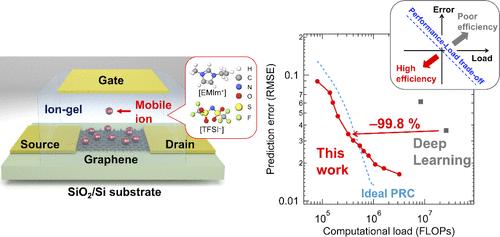离子门控水库的超宽带响应使计算负荷降低了两个数量级
IF 16
1区 材料科学
Q1 CHEMISTRY, MULTIDISCIPLINARY
引用次数: 0
摘要
传统人工智能系统不断增长的能源需求凸显了对高效计算技术的需求,比如大脑启发计算。物理储层计算(PRC)利用物理系统的非线性动力学进行信息处理,已经成为一种很有前途的神经形态计算方法。然而,目前的PRC系统受到狭窄的响应时间尺度和有限的性能的限制。为了解决这些挑战,一种基于离子凝胶/石墨烯双电层(EDL)晶体管的离子门控储层(IGR)被开发出来。这种IGR通过离子凝胶/石墨烯界面的快速EDL动力学和石墨烯表面较慢的分子吸附动力学共存,实现了高度可调和超宽的时间尺度响应。因此,该系统显示出异常宽的响应范围,从1 MHz到20 Hz,同时保持高信息处理能力和跨多个时间尺度的适应性。IGR在混沌时间序列预测任务中实现了深度学习(DL)级别的精度,同时将计算资源需求降低到DL所需的1/100。主成分分析表明,IGR的优异性能源于其高维性,由EDL的超宽带响应和石墨烯的双极性行为驱动。提出的IGR在提供低功耗、高性能计算解决方案方面迈出了重要一步,特别是在资源受限的边缘环境中。本文章由计算机程序翻译,如有差异,请以英文原文为准。

Two Orders of Magnitude Reduction in Computational Load Achieved by Ultrawideband Responses of an Ion-Gating Reservoir
The rising energy demands of conventional AI systems underscore the need for efficient computing technologies, such as brain-inspired computing. Physical reservoir computing (PRC), leveraging the nonlinear dynamics of physical systems for information processing, has emerged as a promising approach for neuromorphic computing. However, current PRC systems are constrained by narrow responsive time scales and limited performance. To address these challenges, an ion-gel/graphene electric double layer (EDL) transistor-based ion-gating reservoir (IGR) was developed. This IGR achieves a highly tunable and ultrawide time-scale response through the coexistence of fast EDL dynamics at the ion-gel/graphene interface and slower molecular adsorption dynamics on the graphene surface. Consequently, the system demonstrates an exceptionally broad responsive range, from 1 MHz to 20 Hz, while maintaining a high information processing capacity and adaptability across multiple time scales. The IGR achieved deep learning (DL)-level accuracy in chaotic time series prediction tasks while reducing computational resource requirements to 1/100 of those needed by DL. Principal component analysis reveals the IGR’s superior performance stems from its high-dimensionality, driven by the ultrawideband responses of the EDL along with the ambipolar behavior of graphene. The proposed IGR represents a significant step forward in providing low-power, high-performance computing solutions, particularly for resource-constrained edge environments.
求助全文
通过发布文献求助,成功后即可免费获取论文全文。
去求助
来源期刊

ACS Nano
工程技术-材料科学:综合
CiteScore
26.00
自引率
4.10%
发文量
1627
审稿时长
1.7 months
期刊介绍:
ACS Nano, published monthly, serves as an international forum for comprehensive articles on nanoscience and nanotechnology research at the intersections of chemistry, biology, materials science, physics, and engineering. The journal fosters communication among scientists in these communities, facilitating collaboration, new research opportunities, and advancements through discoveries. ACS Nano covers synthesis, assembly, characterization, theory, and simulation of nanostructures, nanobiotechnology, nanofabrication, methods and tools for nanoscience and nanotechnology, and self- and directed-assembly. Alongside original research articles, it offers thorough reviews, perspectives on cutting-edge research, and discussions envisioning the future of nanoscience and nanotechnology.
 求助内容:
求助内容: 应助结果提醒方式:
应助结果提醒方式:


